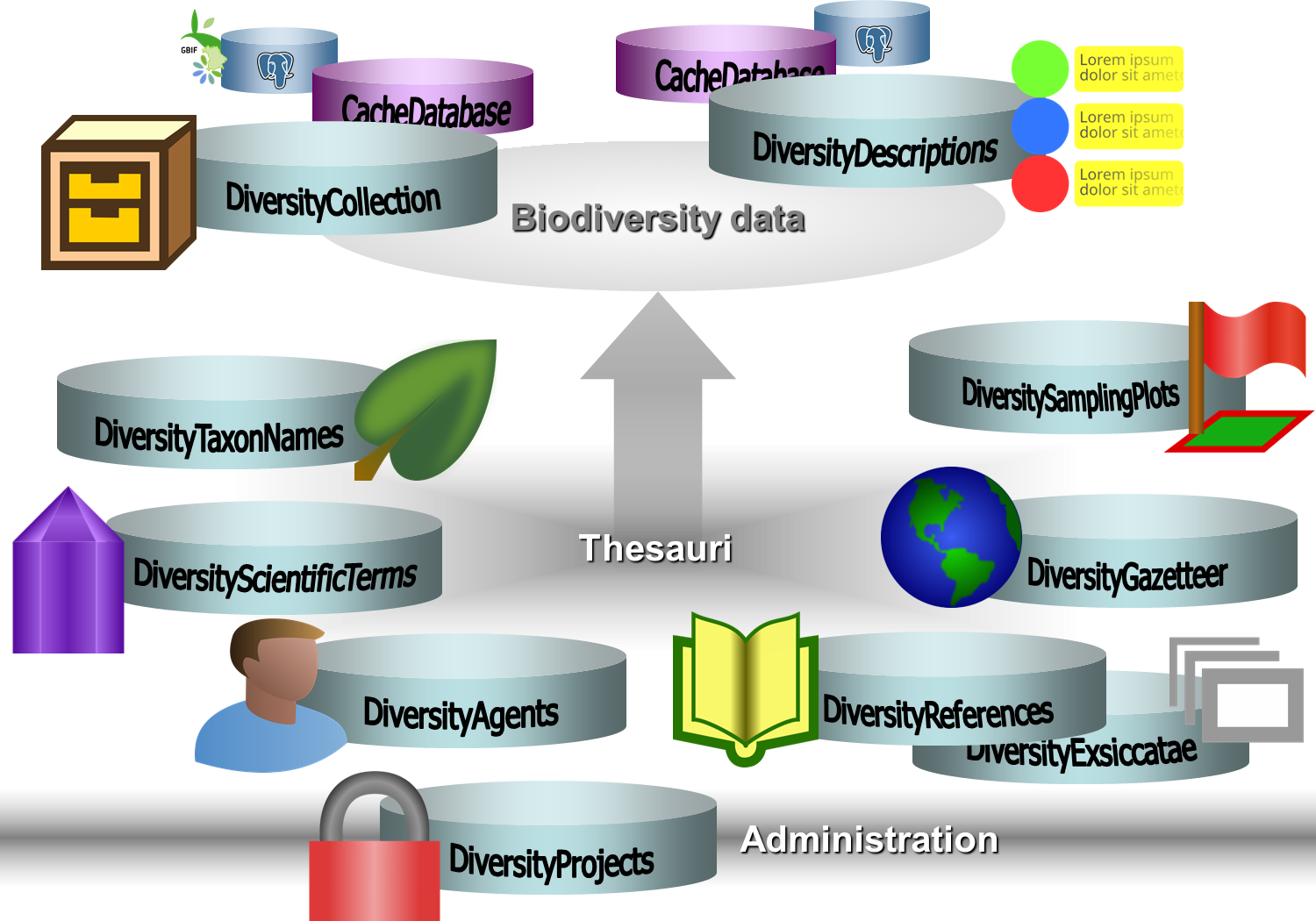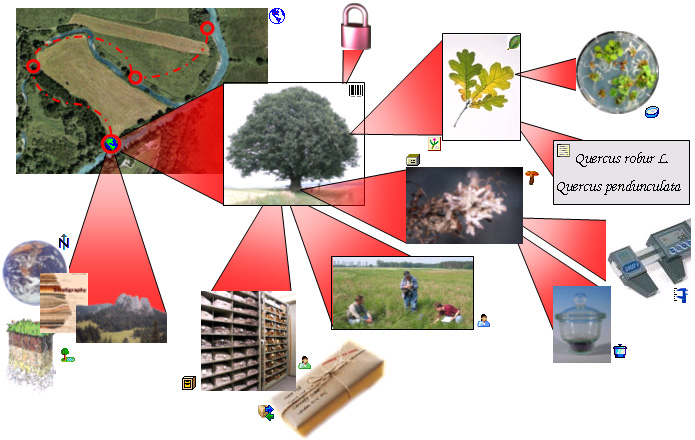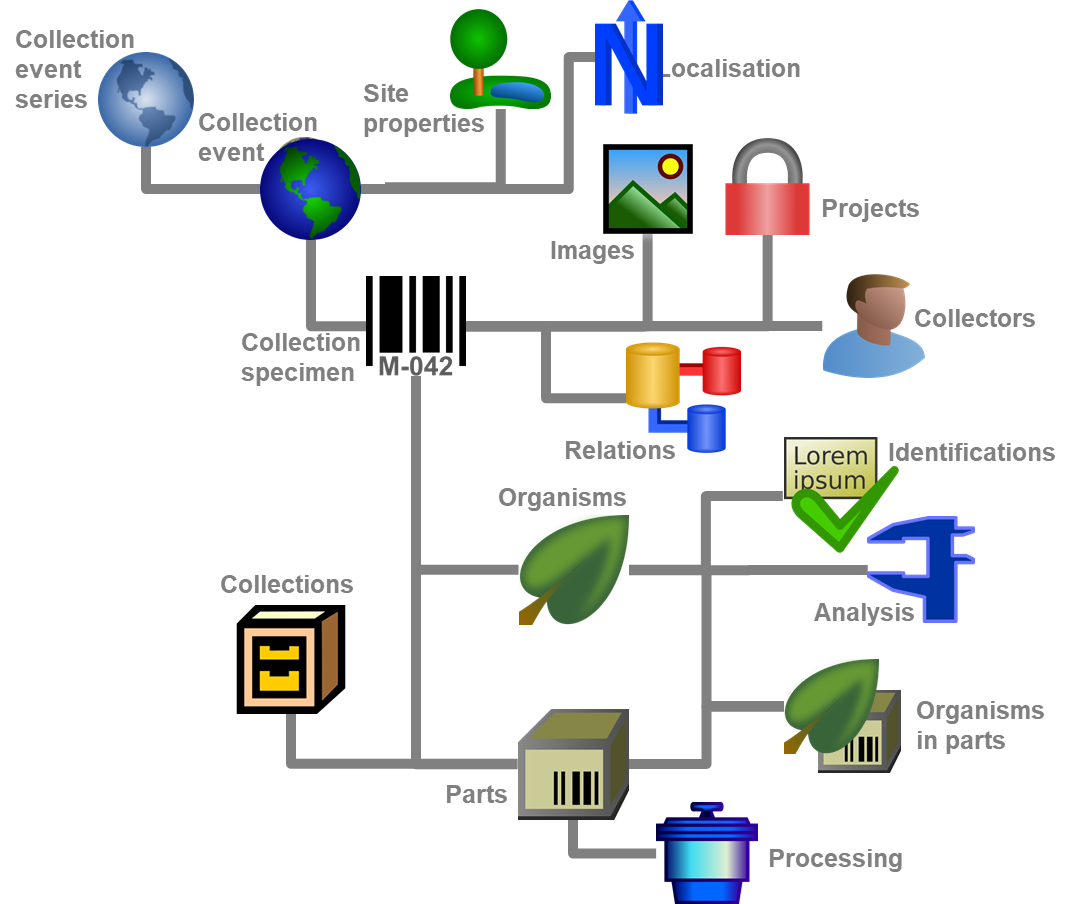Diversity Collection
Scope of DiversityCollection within the Diversity Workbench
DiversityCollection is part of the database framework DiversityWorkbench. Within this framework, the application DiversityCollection is confined to the management of specimens in scientific collections. In this context, it is designed to document any action concerning the collection, storage, exchange, and treatment of specimens in a collection and is also appropriate for storing observation data. DiversityCollection is distinguished from other collection management systems by focusing on the biological relationships between organisms collected together as one or more specimens (e.g. host, parasite and hyperparasite, symbionts, etc.). Each module within the Diversity Workbench is focused on a specific data domain. DiversityCollection stores only data connected with the handling of collection specimens and observations. Data from other realms, such as taxonomy, are handled in separate modules. For an overview of the available modules, see the image below. DiversityCollection can also be used as a stand-alone application.

Outline
The central entity in DiversityCollection is the Specimen. It represents the observed or collected ’thing’, which may be, for example, a plant, an animal, a fossil, or a mineral. The gathering of a specimen takes place in an event. For each specimen, detailed descriptions of place can be recorded. For most specimens, only a part. The specimen is or contains one or more objects that are organisms, minerals, etc. and are called units or organisms in DiversityCollection. Taxonomic identification is based on the unit level. A unit can stretch over several parts, and a part can contain several units.
Data management sectors of the application
| Sector | Description |
|---|---|
 Series Series |
An expedition, monitoring or similar that involves the  collection event or observations at single spots collection event or observations at single spots |
 Event Event |
The location of an observation or the spot where  a specimen was collected during, for example, an a specimen was collected during, for example, an  expedition expedition |
 Localisation Localisation |
Localisation of an observation or collection site |
 Site Property Site Property |
Properties of e.g. a collection site like the type of the habitat |
 Collecting Method Collecting Method |
Methods used for the observation or collection of specimen |
 Specimen Specimen |
Observed or collected specimen like those collected during a collection event |
 Collector Collector |
The observers or collectors of specimen |
 Objects Objects |
The objects like taxa or minerals observed or collected |
 Identification Identification |
Identifications of the organisms, minerals etc. |
 Analysis Analysis |
Any analysis applied to characterise the objects |
 Analysis methods Analysis methods |
The methods that have been used to analyse the objects |
 Part Part |
The parts of a collected specimen that are stored in a collection, e.g. as herbarium sheets |
 Collection Collection |
The collection where the collected objects are stored |
 Processing Processing |
Processing applied to the parts of a specimen |
 Processing methods Processing methods |
Methods that have been used for the processing |
 Transaction Transaction |
Actions like sending specimen as a loan to another collection |
 Project Project |
The projects that a specimen is a part of |
 Images Images |
Can be taken for the EventSeries, the CollectionEvent, the CollectionSpecimen as well as organisms and parts of a specimen |
 References References |
The references related to a specimen, organism, identification or part of a specimen |
Usage example
The image below gives an overview of some typical data represented in DiversityCollection, along with the symbols used throughout the program. In this example, a herbarium sheet containing a plant collected during an expedition is identified and analysed. The herbarium sheet is loaned to another collection where a DNA sample is extracted. All this information about the specimen, its storage, treatment, and derived information is stored in DiversityCollection:
- A typical specimen
may have been collected at a CollectionEvent
during an expedition.
. The site of the CollectionEvent can be localised
and characterised
and methods
have been used. The collectors
collected twigs of the plant
and fungi
 growing on the plants.
growing on the plants. - The organisms on the specimen were identified
several times and analysed
where methods
have been used.
- The collected samples are stored as herbarium sheets
 and specimens
and specimens
in a collection.
.
- The manager
 sent
some of the samples
sent
some of the samples for which he had a request
 from a requester
from a requester
to another collection.
- The samples were collected as part of a project
.
- Certain parts were cultivated
 and DNA
and DNA  extracted which was processed
extracted which was processed where methods
have been used.
- Images
were taken for the EventSeries, the CollectionEvent, the CollectionSpecimen as well as organisms and parts of this specimen.

Main sectors
The image below gives you a simplified overview of the main parts of the DiversityCollection database.

For details in various sections see the overviews
DiversityCollection 4.x is based on Microsoft SQL-Server 2016 or later and the .Net Framework, Version 4.8.
For licence and copyright see the licence section.

